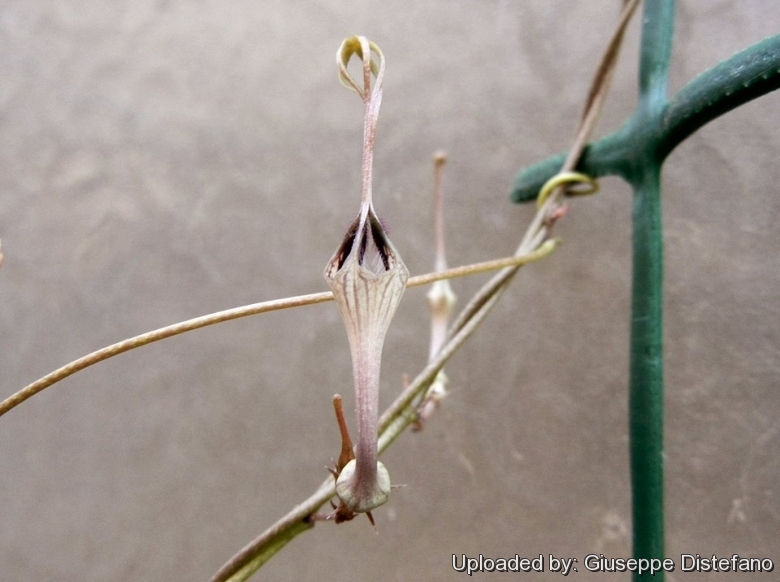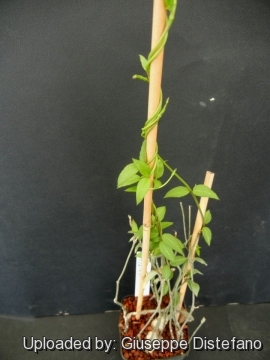Accepted Scientific Name: Ceropegia africana subs. barklyi (Hook.f.) Bruyns
Bradleya 3: 35 1985.

Ceropegia barklyi (Ceropegia africana subs. barklyi) Photo by: Giuseppe Distefano
Origin and Habitat: Eastern Cape, South Africa.
Synonyms:
See all synonyms of Ceropegia africana
Description: Ceropegia africanaSN|26946]]SN|26946]] subsp. barklyi (often mispelled barckleyi) is a smaller fascinating climbing plant with a swollen underground tuber looking like the standard Ceropegia africanaSN|26946]]SN|26946]], but with especially elongated corolla lobes which are proportional in lengths with corolla-tube. The corolla lobes are gracefully joined, and are festooned with dark hairs. The flowers usually appear in Summer. The vines climb a short distance before blooming and the tuber is dormant during the winter. It has also an attractive shape and decorative succulent leaves often with nice silver markings, but the green underlay of its leaves turns a rosy-purple when exposed to strong, though not burning, light. It is quite variable.
Rootstock: Perennial tuberous flattened, sometimes with secondary tubers.
Stem: up to 100 (or more) cm long, 1-2 mm in diameter, poorly to weakly twining, glabrous, mainly annual (varying greatly in robustness from the southern to northern range of distribution). The stems sometime form rhizomes with swollen nodes.
Leaves: Fleshy, glabrous, petiole 2-5 mm long; lanceolate blade 1.5-4 cm long, to 20 mm broad, acute, mucronate or apiculate, rounded or broadly subcuneate at the base sometimes undulate. Upper face green or with silver markings (depending on clones), lower face purple.
Inflorescences (cymes): Pedunculate, lateral at the nodes, 2–3-flowered; peduncles 2-6(-15) mm long, glabrous.
Flowers: Pedicels 2-4(-10) mm long, glabrous. Sepals subulate about 2.5 mm long. Calix base swollen, calyx 2.5-5 cm long with a basal globose inflation, sligtly 5-angled and costricted in the lower half, about 3.5 mm in diameter, inside purple hairless. Corolla-lobes, basally purple, thin, liner somewhat twisted together, usually joined above the middle, with hairs on the base and often along the margins too. Corona almost sessile. Outer corona-lobes 1-1.5 mm long broader than the inner corona.
Subspecies, varieties, forms and cultivars of plants belonging to the Ceropegia africana group
- Ceropegia africana R.Br.: has corolla lobes noticeably shorter than corolla-tube. Distribution: Cape Peninsula, South Africa.
 Ceropegia africana subs. barklyi (Hook.f.) Bruyns: distinguished by the proportional lengths of corolla-tube and corolla-lobes. Distribution: Eastern Cape, South Africa.
Ceropegia africana subs. barklyi (Hook.f.) Bruyns: distinguished by the proportional lengths of corolla-tube and corolla-lobes. Distribution: Eastern Cape, South Africa.
Bibliography: Major references and further lectures
1) N. E. Brown “Flora Capensis” Vol 4, 1909
2) Dr J.P. Roux "Flora of South Africa". 2003
3) Focke Albers, Ulrich Meve “Illustrated Handbook of Succulent Plants: Asclepiadaceae” Volume 4 Springer, 2002
 Ceropegia barklyi (Ceropegia africana subs. barklyi) Photo by: Giuseppe Distefano
Ceropegia barklyi (Ceropegia africana subs. barklyi) Photo by: Giuseppe Distefano Ceropegia barklyi (Ceropegia africana subs. barklyi) Photo by: Giuseppe Distefano
Ceropegia barklyi (Ceropegia africana subs. barklyi) Photo by: Giuseppe DistefanoCultivation and Propagation: This species is of easy cultivation and it can be deciduous in winter if kept cold and dry. It forms the most striking trailing stems if grown in a suspended basket. However the flowers are most interesting and worth the trouble, only bearing in mind that this species benefits from slightly warmer winter than others.
Soil: This plant does well in a rich cactus potting mix, but can become too elongated if compost is too rich. Use pot with good drainage.
Transplantation: Repotting every 2-3 years. The trick is to be as careful as possible, as it falls apart easily. Add some potting mix (compost) to the new container to bring the repotted plant to the correct height. Cautiously upturn the old container, supporting the plant with a gentle hand, position the root ball into the new container, add extra potting mix to fill any empty spaces, and carefully arrange the pearls to hang over the pot.
Watering: The plant will take regular water and fertilizer in summer. Rot prone in winter; keep on the dry side and water only enough to keep the tuber from shrivelling. Care must be taken with watering as they tends to become swollen and untidy in growth habit if given too much water and shade.
Hardiness: Frost tender. Plants grown outdoors may endure relatively wet, cold rainy winters.
Exposure: It prefers filtered sun or light shade, but the tuber should stay constantly in the shade.
Pest & diseases: They are pest free outdoors, but may attract white flies if kept in humid greenhouse environments, and some kind of control might be needed. Treat for aphids and mealy bugs if they appear. Rot it is only a minor problem if the plants are watered and “aired” correctly. If they are not, fungicides won't help all that much.
Growing practices: The stem grows over a meter long and and is best trained around a hoop or up a framework, but tends to vine around nearby plants if kept in a pot on a shelf, so it needs to be controlled a bit... give it something to wind around to keep it away from the other plants.
Propagation: It is best propagated from seed or cuttings. Stem cuttings are easy to propagate, cut off strings near a node and stick them into fresh soil to restart. The cuttings should root in 2 to 6 weeks. It will form potato-like lumps under the soil.













